Like all sailors that have a home shop and work on their boats, we’re constantly schlepping tools back and forth. I have multiples of many tools, but not everything, and it’s not good having every tool on the boat—I’d have to repaint the waterline three inches higher and there would be no room for stores. This article was further inspired by an increasing need to schlep tools cross country in support of my engineering consulting work. Showing up fully organized reduces stress, speeds work, and demonstrates to the customer that you know what you’re doing and that they are getting their money’s worth. And isn’t your time just as valuable when you go to the boat to work?
How much do we take? Daysailing, racing, and smaller boats suggest lightweight kits, sufficient to get you back to the dock and never out of proportion to the size of the boat. Long distance cruising and boats kept far from home suggest a more comprehensive approach. Examine every important system on the boat. Do you have the tools to tighten, loosen, remove, and install everything? Do you have workable spares for every nut, bolt, screw, clip electrical connector, filter, and maintenance part, stopping short of shipping a spare boat? There are a range of answers.
Corrosion. Left to settle in the bottom of a box, drills, hacksaw blades, and seldom used wrenches become welded together by rust into an unidentifiable lump. All it takes is a little moisture, which will be retained securely by watertight seals. Canvas rolls, by comparison, do an excellent job of fighting corrosion. They breathe, allowing tools to dry. Additionally, they hold just enough oil to keep corrosion at bay. Avoid clear vinyl rolls. Although it’s nice to see what’s there, the plastic gets stiff and the tools rust just as badly as in a metal or plastic box.

Preservative Oils. Tools can be too clean. Rinse off the salt and wipe them dry, and then wipe them down with a rag that has just a trace of motor oil or your favorite preservative, such as Corrosion Block; not so much that you can really feel it, but enough that you wouldn’t consider it clean. Maybe you used it to wipe off the dipstick once or twice. That is what my grandfather taught me, 50 years ago, and I still use his wrenches. I’m not wild about oily tools, but nothing else does as much to prevent rust.
THE BIG LIST OF TOOL KITS
As I get older I find myself subdividing my portable tool collection into lighter kits, each for a subject area. I can’t lug a 40-pound bag anymore and I can find what I need far more quickly in smaller, focused kits. Like the three bears, each pack must be not too big and not too small. But before we argue the details, we must define the function of each kit:
GENERAL KITS
Two versions. The first is for simple boats, the second is the starting point for more comprehensive cruising boat kits.
ULTRALIGHT KIT
On a dinghy it combines day needs (sunscreen and minor first aid) and a very few basic tools. On my sport boat it is pure tool bag, since my day bag contains the food, water, radio and such. It is complemented by a small plastic tray of shackles, blocks, and basic spares. This is a simple practical kit well suited for a simple, practical boat.
GET-HOME KIT
This multipurpose kit stays in my car much of the time, and is suitable for many minor fix-it tasks at my home, my parents’ home, my daughter’s home, and unfamiliar boats I sail on. I’ll carry it down the dock for minor stuff on the sport boat, and it is also general purpose kit for my larger boat.
SPECIALIZED KITS
These kits aim to complement rather than duplicate the tools in the general kits.

ELECTRICAL KIT
This holds a wirestripper and crimpers, small spools of wire, a multitude of fittings, switches, connectors, bulbs, fuses, supplies, and components.
RIGGING KIT
This kit includes ball bearing blocks, spare cam cleats. It also holds critical items for jury rigs, such as snatch blocks, low friction rings and soft shackles.
SEWING KIT
Needles, thread and twine, awls, webbing, some spare fabric, sail repair tape, slugs, and my sailor’s palm go here.
MECHANICAL KIT
This is the home for wrenches and punches, saw blades, chisels, hammers and screwdrivers.

POWER TOOLS
Since my cruising ground is close to home, I carry only a cordless drill. The rest live on shelves at home, so I just grab what I need. Long term cruisers will carry a variety. An oscillating multi-tool is a favorite—handy in an emergency for accessing hull damage hidden behind interior liners.
GLUE AND SEALANTS
I keep a few containers of bedding sealant, underwater epoxy, and 5-minute epoxy on the boat for emergencies.
PAINTING, EPOXY, AND LAMINATING KIT.
These are the big guns, for repainting, major fiberglass repairs, or perhaps just sealing core before installing hardware on a cored deck. I keep these at home and transfer them in cardboard boxes that I can throw away on-site when empty. A reinforced six-pack drink carton can be perfect for a mini-epoxy kit, including mixing sticks, thickener, a few bits of glass cloth, syringes, tiny brushes, and disposable gloves. Tape the bottom for added sturdiness, and just pitch it in the garbage when it gets gloppy. You’ve got more.
FITTINGS AND FASTENERS
Sail long enough, and you will accumulate hundreds of used and surplus fasteners and small fittings. The right screw can often save the day when one is broken or dropped.
JOB-SPECIFIC PARTS.
I try to pre-package the specific needs of any defined project of any job, including drills, bolts, and small parts required to install. This avoids time wasted hunting around, and nothing critical gets forgotten.
CLEANING KIT
I don’t need that many products to clean the boat, but I’m annoyed if I’m missing the right brush or the one thing I need for a certain stain. So I keep the basic stuff all in one bag (see “One Bucket Cleaning Kit”).
VALUE GUIDE: BOAT CARE KITS, BAGS, BUCKETS, AND BOXES
| TYPE | BRAND | MODEL | POCKETS | NOTES | APPROX. LOADED WEIGHT | DIMENSIONS ( L X W X H)** | CUBIC INCHES (INSIDE) | PRICE |
|---|---|---|---|---|---|---|---|---|
| ELECTRICIAN'S BAG | Husky | 9-inch Electrician's bag | 28 | Handier size for climbing: hangs for working aloft. Fabric bags are not as durable as leather, but they are lighter. | 20 lbs. | 9 x 9 x 10 in. | 729³ in. | NA* |
| ELECTRICIAN'S BAG | Husky | 10-inch Electrician's bag | 40 | Hangs for working aloft on the mast | 28 lbs. | 10 x 10 x 10 in. | 1,000³ in. | $40 |
| ELECTRICIAN'S BAG | Klein | Tradesman Pro 8-inch Tote 554158-14 | 20 | Hangs for working aloft on the mast | 20 lbs. | 9 x 9 x 10 in. | 850 in. | $70 |
| BACKPACK | Klein | Tradesman Pro Tool Backpack 55421BP-14 | 35 | Carry on your back, Stands for access | 35 lbs. | 15 x 20 x 8 in. | 2,175³ in | $90 |
| BAG | CLC Custom Leather Craft | 1132 Tool backpack | 75 | Carry on your back, Favorite of organization freaks | 35 lbs. | 13 x 18 x 9 in. | 2,047³ in. | $130 |
| TACKLE BOX | Plano | Rack System 3700 tackle box 137401 | 4-trays | Top section holds hand tools and meters; excellent for fasteners and electrical fittings | 20 lbs. | 17 x 16 x 12 in. | 3,381 in. | $48 |
| TOTE BAGS | LL Bean | Boat and Tote, Open Top | Double layer, 24-pound cotton canvas; Stays open | 20-40 lbs. | 17 x 15 x 8 in. | 1,912³ in. | $35 | |
| MODULAR CART SYSTEMS | Dewalt | Tough System 2.0 | 2-5 tool boxes | Accessory boxes include multiple tool box types and small parts organizers | ~200 pounds | 24 x 38 x 17 in. | 5,800 in. | About $190 and up |
| FOLDING CART | Pack-N-Roll | 18-inch utility cart | Best on smooth surfaces; Folds to 3" x 18 x 19"; keep loads under 50 pounds | Up to 85 lbs. | 16 x 14 x 17 in. | 3,808³ in. | $25 | |
| TOOL ROLLS | Many brands and DIY | Wrench Wrap | 6-12 | Simple is better; fits better in tool bags; waxed cotton canvas protects against rust; avoid vinyl, it attracts rust | 1-3 lbs. | Varies | 48³ in. | $8-$12 |
| ~12 x 10 x .5 in. |
In a dream world we’d drag along our own hardware store, but the limited carrying ability of most cruising boats — not to mention the limited budget of their skippers—requires selectivity. In many cases, the best tool for the job can be replaced by a substitute that is less expensive, less bulky, and just as functional. Inexpensive cable clamps, for example, are good for making rigging repairs.
Here are some of our favorite tool reports, many of them provided by longterm cruisers.
“Tool Tips,” PS March 2018.
“The Get Home Toolkit,” PS November 2018
“The One-bucket Cleaning Kit,” PS May 2017
“Digital Diagnostic Tools,” PS December 2020
“What’s in the Practical Sailor Tool bag,” PS January 2012
“Ocean Tested: A Professional Carpenter and Cruiser Tells Practical Sailor What’s in His Power-tool Box,” PS November 2007
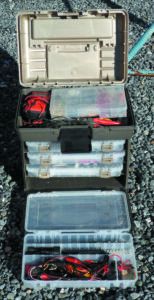
1. A sturdy tackle box is perfect for smallparts like electrical connectors. I also have a smaller one I use as a multipurpose mechanical kit at home.
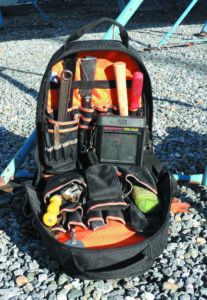
2. A favorite for cruising handypersons, the Klein Tool Pack goes almost anywhere. We like that it stands in the open position.

3. Some favorite dockside haulers. The folding cart has weight terrain limits, but folds flat. The five gallon bucket adapts to every need. The canvas bag lasts forever, and the rugged dry bag keeps essential tools dry.
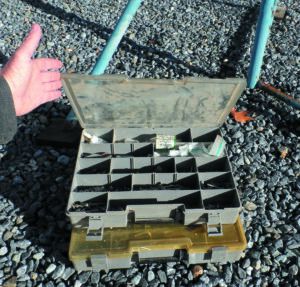
4. Look for rugged organizers with secure closures. A cheap one will pop open at the worst moment.
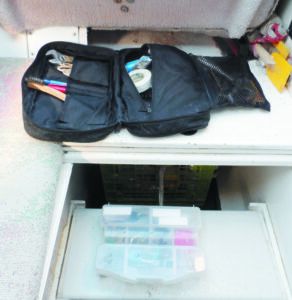
5. A travel bag for toiletries makes a great compact kit for small boats.
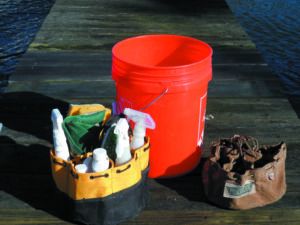
6. Parachute bags are great for cleaning supplies. They fit right in a bucket. We also use them for fasteners.

This article was originally published on 22 March 2022 and has been updated.





































